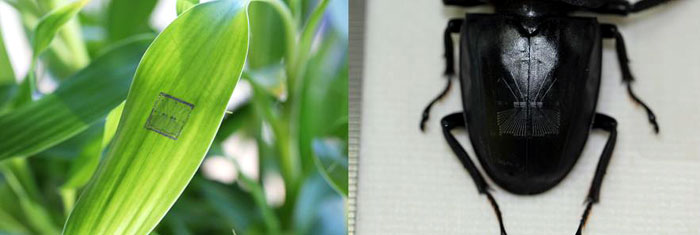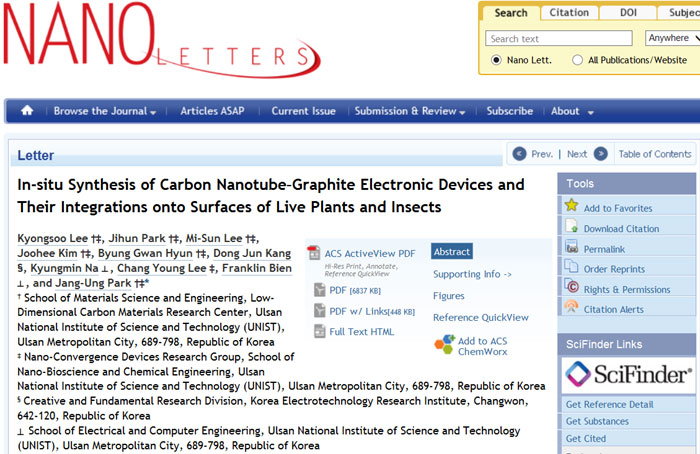-
 Korea.net's 24-hour YouTube channel
Korea.net's 24-hour YouTube channel- NEWS FOCUS
- ABOUT KOREA
- EVENTS
- RESOURCES
- GOVERNMENT
- ABOUT US
A group of researchers has developed an electronic device that can sense toxic or radioactive materials, as well as temperature and humidity, upon attachment to the surface of a living plant or insect.

The group of scientists, including Professors Park Chang-ung, Lee Kyoungsoo, Lee Chang Young and Bien Young-Jae, all of the Ulsan National Institute of Science and Technology (UNIST), developed a sticker-sized electronic device that can sense toxic gas. This device is made of synthesized carbon nanotubes and graphite.
Carbon nanotubes conduct electricity extremely well and are a strong solid that cannot be easily damaged. They are also very flexible and can still conduct electricity even if bent. Perfect for this task, carbon nanotubes also have a strong reaction to chemicals such as gas molecules.
The researchers tested the electronic device by putting it on the surface of living plants and on a stag beetle. The device successfully sensed toxic gas while transmitting electricity and relayed the information using wireless communication technology.
The research was partially funded by the Ministry of Science, ICT & Future Planning as part of its research support policy. The results were reported online in the May 8 edition of Nano Letters, an international academic journal focused on the nano science sector.

This high-performance electronic device is very light and highly portable, and therefore can be applied to the development of wearable electronic modules. If this technology is commercialized, it could be further applied to new technologies that can check temperature or humidity by smartphone. The technology is also expected to be used in the development of sensors that can relay information about radioactive contamination from areas where humans can't easily access, such as after nuclear leaks or terrorist attacks.

“This technology can be applied to the development of wearable electronic devices, as it can be attached to a two-dimensional bio sensor or even onto a living plant or animal,” said Professor Park.
By Yoon Sojung
Korea.net Staff Writer
arete@korea.kr

Professor Park Jang-Ung of the Ulsan National Institute of Science and Technology (UNIST)
The group of scientists, including Professors Park Chang-ung, Lee Kyoungsoo, Lee Chang Young and Bien Young-Jae, all of the Ulsan National Institute of Science and Technology (UNIST), developed a sticker-sized electronic device that can sense toxic gas. This device is made of synthesized carbon nanotubes and graphite.
Carbon nanotubes conduct electricity extremely well and are a strong solid that cannot be easily damaged. They are also very flexible and can still conduct electricity even if bent. Perfect for this task, carbon nanotubes also have a strong reaction to chemicals such as gas molecules.
The researchers tested the electronic device by putting it on the surface of living plants and on a stag beetle. The device successfully sensed toxic gas while transmitting electricity and relayed the information using wireless communication technology.
The research was partially funded by the Ministry of Science, ICT & Future Planning as part of its research support policy. The results were reported online in the May 8 edition of Nano Letters, an international academic journal focused on the nano science sector.

All-carbon electronic devices are attached to the surface of plants or insects. Once attached, the device can sense gas and transmit data through a wireless communication system without causing any negative effects for the host. (photos courtesy of the Ministry of Science, ICT & Future Planning)
This high-performance electronic device is very light and highly portable, and therefore can be applied to the development of wearable electronic modules. If this technology is commercialized, it could be further applied to new technologies that can check temperature or humidity by smartphone. The technology is also expected to be used in the development of sensors that can relay information about radioactive contamination from areas where humans can't easily access, such as after nuclear leaks or terrorist attacks.

A captured image of the May 8 edition of Nano Letters which published an article about carbon nanotube-graphite electronic sensors.
“This technology can be applied to the development of wearable electronic devices, as it can be attached to a two-dimensional bio sensor or even onto a living plant or animal,” said Professor Park.
By Yoon Sojung
Korea.net Staff Writer
arete@korea.kr













